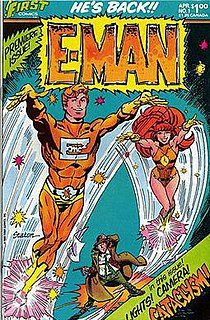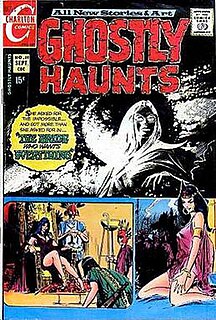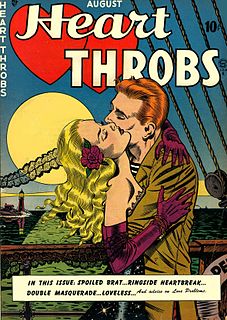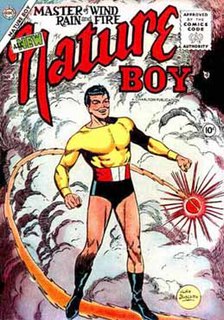
Quality Comics was an American comic book publishing company which operated from 1937 to 1956 and was a creative, influential force in what historians and fans call the Golden Age of Comic Books.

Fawcett Comics, a division of Fawcett Publications, was one of several successful comic book publishers during the Golden Age of Comic Books in the 1940s. Its most popular character was Captain Marvel, the alter ego of radio reporter Billy Batson, who transformed into the hero whenever he said the magic word "Shazam!".
Mainline Publications, also called Mainline Comics, was a short-lived, 1950s American comic book publisher established and owned by Jack Kirby and Joe Simon.

E-Man is a comic-book character, a superhero created by writer Nicola Cuti and artist Joe Staton for the American company Charlton Comics in 1973. Though the character's original series was short-lived, the lightly humorous hero has become a cult-classic sporadically revived by various independent comics publishers. Ownership of the character has changed hands over the years, moving from the original publisher to the character's creators.

Young Love was one of the earliest romance comics titles, published by Crestwood/Prize, and later sold to DC Comics.

Crestwood Publications, also known as Feature Publications, was a magazine publisher that also published comic books from the 1940s through the 1960s. Its title Prize Comics contained what is considered the first ongoing horror comic-book feature, Dick Briefer's "Frankenstein". Crestwood is best known for its Prize Group imprint, published in the late 1940s to mid-1950s through packagers Joe Simon and Jack Kirby, who created such historically prominent titles as the horror comic Black Magic, the creator-owned superhero satire Fighting American, and the first romance comic title, Young Romance.
St. John Publications was an American publisher of magazines and comic books. During its short existence (1947–58), St. John's comic books established several industry firsts. Founded by Archer St. John, the firm was located in Manhattan at 545 Fifth Avenue. After the St. John comic books came to an end in 1958, the company continued to publish its magazine line into the next decade. Flying Eagle Publications was a magazine affiliate of St. John Publications. Comic book imprints included Approved Comics, Blue Ribbon, and Jubilee Publications.

Young Romance is a romantic comic book series created by Joe Simon and Jack Kirby for the Crestwood Publications imprint Prize Comics in 1947. Generally considered the first romance comic, the series ran for 124 consecutive issues under Prize imprint, and a further 84 published by DC Comics after Crestwood stopped producing comics.

Horror comics are comic books, graphic novels, black-and-white comics magazines, and manga focusing on horror fiction. In the US market, horror comic books reached a peak in the late 1940s through the mid-1950s, when concern over content and the imposition of the self-censorship Comics Code Authority contributed to the demise of many titles and the toning down of others. Black-and-white horror-comics magazines, which did not fall under the Code, flourished from the mid-1960s through the early 1980s from a variety of publishers. Mainstream American color comic books experienced a horror resurgence in the 1970s, following a loosening of the Code. While the genre has had greater and lesser periods of popularity, it occupies a firm niche in comics as of the 2010s.
Toby Press was an American comic-book company that published from 1949 to 1955. Founded by Elliott Caplin, brother of cartoonist Al Capp and himself an established comic strip writer, the company published reprints of Capp's Li'l Abner strip; licensed-character comics starring such film and animated cartoon properties as John Wayne and Felix the Cat; and original conceptions, including romance, war, Western, and adventure comics. Some of its comics were published under the imprint Minoan. Some covers bore the logo ANC, standing for American News Company, at the time the country's largest newsstand distributor.
Alan Class Comics was a British comics publishing company between 1959 and 1989, owned by Alan Class. The company produced anthology titles, reprinting comics stories from many U.S. publishers of the 1940s to 1960s in a black and white digest format for a UK audience.

Sweethearts was a romance comic book series published by Fawcett Publications from October 1948 to 1953, and continued by Charlton Comics from 1954 to 1973. It was the first monthly romance comic book, and a great commercial success. Fawcett followed the title with other monthly romance titles including Life Story (1949), Cowboy Love (1949), and Romantic Secrets (1950).

Moon Girl is a fictional character published by EC Comics. Created by Max Gaines, Gardner Fox and Sheldon Moldoff. Moon Girl is a character from the Golden Age of Comic Books and has since slipped into the public domain.

Haunted was a horror-suspense anthology comic book series published by Charlton Comics from 1971 to 1984. The book was "hosted" by Impy, a pint-sized ghost dressed in an all-white superhero costume. With issue #21, the book's host became Baron Weirwulf. From that point forward, Haunted's title was changed to Baron Weirwulf's Haunted Library.

Ghostly Haunts was an American horror-suspense anthology comic book series published by Charlton Comics from 1971 to 1978. The book was "hosted" by Winnie the Witch, a "moddish" blue-skinned witch.

I Love You was a romance comic published by Charlton Comics from 1955–1980.

Heart Throbs was a romance comic published by Quality Comics and DC Comics from 1949 to 1972. Quality published the book from 1949–1957, when it was acquired by DC. Most issues featured a number of short comics stories, as well advice columns, text pieces, and filler. The long-running feature "3 Girls—Their Lives—Their Loves," drawn by Jay Scott Pike and inked by Russ Jones, ran in Heart Throbs from 1966–1970.
Farrell Publications is the name of a series of American comic book publishing companies founded and operated by Robert W. Farrell in the 1940s and 1950s, including Elliot Publishing Company, Farrell Comic Group, and Excellent Publications. Farrell is particularly known for its pre-Comics Code horror comics, mostly produced by the S. M. Iger Studio. Farrell also published romance, Western, adventure, superhero, and funny animal comics. Farrell acted as editor throughout. In addition to packaging art for Farrell from the beginning, Jerry Iger was the company's art director from 1955–1957.

Haunted Love was a horror-romance anthology comic book series published by Charlton Comics from 1973 - 1975. It was part of the Gothic Romance comic book mini-trend of the era, which included the short-lived DC Comics series The Dark Mansion Of Forbidden Love and The Sinister House of Secret Love, and Atlas/Seaboard Comics' one-shot magazine Gothic Romances.















